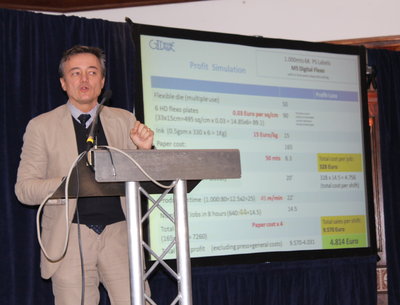Federico d’Annunzio,managing director of Gidue
In the wake of drupa, BPIF Labels invited suppliers and printers to a seminar for a technical update. It was the first of two planned technical seminars this year and 55 delegates met to discuss what the latest developments as seen at the show mean for the industry. By Neel Madsen.
One of the dominant themes at drupa was digital technologies aimed at the packaging and labels market, and the seminar continued to explore this with presentations from a number of main suppliers in this field.
Chairman John Bambery said, ‘Although traditionally, the label industry gathers at Labelexpo, it was evident at drupa this year that the industry was very well represented. In particular, we saw the emergence of very sophisticated digital presses, some of which have been launched by manufacturers that were unknown to us in 2008.’
Neil Falconer from Printfuture presented an overview of the global print market. He described drupa as the tipping point for inkjet and said that digital really is upping its game with a projected growth of nearly 136% from 2009 to 2014. For printers, he listed three big challenges: adapting to change, mismatch of legacy equipment, and new skills and creativity, and emphasised the need to invest in forward-focused production and manufacturing. ‘Successful companies,’ he said, ‘are the ones which reinvest in both equipment and people. You must build future value into your company.’
View from the field
Xeikon’s sales manager, Paul Briggs gave an overview of the products launched, which include the new ThermoFlexx plate processor and expansion of its 3000 press range. Stephen Hancock from Domino spoke about its inkjet solutions for labels and packaging, and how new technologies can add value, win new business and increase profit. Carlo Sammarco, European business manager packaging solutions, summarised Screen’s product portfolio including the new Truepress Jet L350 UV inkjet label press.
‘Esko’s vision is not to say that we are digital or conventional. Most of our customers do both and we have to be able to adapt to make sure they have the best solutions for their businesses,’ said Esko business manager, Paul Bates. He also pointed out that with the acquisition of X-rite and Pantone by Esko’s owners, Danaher, cloud based colour management, in the form of PantoneLive, will come next drupa be the industry standard.
Federico d’Annunzio,managing director of Gidue, presented the M5 Digital Flexo solution which uses digital technology to control each flexo printing station with fully automatic ‘digital’ print pressure and register setup. He said that this enables the press to run at much higher press speeds, and in essence, the operator becomes a product manager responsible for the profitability of the press not just the print quality.
After lunch, Asahi Photoproducts’ focus on ‘creating for tomorrow’ was presented by director David Galton, who explained the advantages of ink pinning technology used in combination with the company’s AWP water wash plates.
The topics of digital finishing and laser die-cutting were covered by AB Graphic’s Matthew Burton. drupa saw four or five different laser die-cutting technologies, which offer large savings in die tooling. One of ABG’s customers in the US has saved over $100,000 in the 12 months since investing in its system and has already ordered a second.
EFIA’s new Academy 2 online training website has been developed by LearningAid Ltd, and in his presentation, managing director Fred Hoyland made a compelling case for the importance of training on all levels.
A panel discussion followed the presentations during which Mr d’Annunzio conceded that for the label industry there is no doubt that ‘in the end we will all become digital.’ There was also some debate about the limitation for the width of digital machines during which a substrates manufacturer noted that it is always playing catch up with new press launches. Comments were also made about the price of ink and the general need to address the cost of consumables.
Future aim
The special interest group for labels under the BPIF was resurrected in 2011 and John Bambery’s aim is that it will become as active in the industry as its German counterpart. He said, ‘We want everyone to join BPIF Labels and we aim to become the main reference point for the self-adhesive label industry in the UK. The industry is alive and well, and we need to get back to the networking that we were so good at once.’
Membership has seen an increase of 33% in the last year and the association is currently working on a comprehensive code of practice for the production of labels for the food and sensitive product sectors.
The next seminar will be held on October 31.






